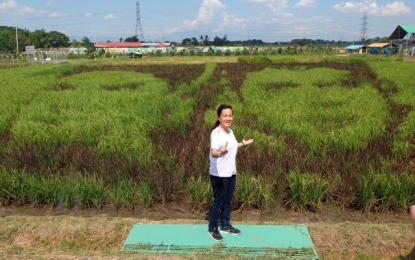News
Poe visits PhilRice’s rice paddy art in Nueva Ecija

The rice paddy art, which is part of the Philippine Rice Research Institute’s (PhilRice) FutureRice project, reportedly piqued the interest of tourists from all over the country. (Photo: Philippine News Agency)
MANILA–After a rice paddy art featuring two generations of “Ang Probinsyano” actors Fernando Poe Jr. (FPJ) and Coco Martin went viral on social media, Sen. Grace Poe traveled to Muñoz, Nueva Ecija to see the paddy for herself.
Poe, daughter of FPJ, visited Barangay Maligaya, Science City in Munoz on Tuesday to see the paddy and hailed the ingenuity of Filipino farmers behind the innovative creation.
The rice paddy art, which is part of the Philippine Rice Research Institute’s (PhilRice) FutureRice project, reportedly piqued the interest of tourists from all over the country.
The purple rice variety was used for the faces of featured actors to give a visual contrast to the regular green-leafed variety in producing the art, PhilRice said. It is available for viewing until May 14.
PhilRice’s program is meant to showcase modern technologies to help prepare rice farmers to cope with climate change and environmental degradation.
Poe, meanwhile, expressed hoped that the continuing research and training at PhilRice could help bolster rice production and bring food security in the country.
“Umaasa tayo na ang kahanga-hangang proyektong ito ay makakapagpalaganap ng interes sa pagsasaka, lalo na sa ating mga kabataan. Ipinapamalas nito ang ating kakayanang maging malikhain para higit na mabigyang pansin ang sektor ng agrikultura,” Poe said.
(“We have high hopes that this amazing project would spread the interest of agriculture, especially among youth. This demonstrates the ability of Filipinos to be creative to give more attention to the agriculture sector,” Poe said.)
The senator also toured the PhilRice laboratories which house the genebank, molecular laboratory, rice chemistry and food science.
The five-hectare farm also showcases clean energy facilities, drone technology, advanced farm machines, and an experimental field that demonstrates hybrid, inbred, and traditional rice varieties.
She noted the importance of raising the productivity of rice lands to get close to, if not match, production costs in our rice exporting neighbors.
“The government, now more than ever, should provide full support to our farmers especially those who are situated in our rice-growing provinces,” Poe said.
In the Philippines, the cost of palay production is at PHP14 per kilogram. However, the cost of palay production in neighboring countries like Vietnam and Thailand is only at PHP6 to PHP7 and PHP8, respectively.





















